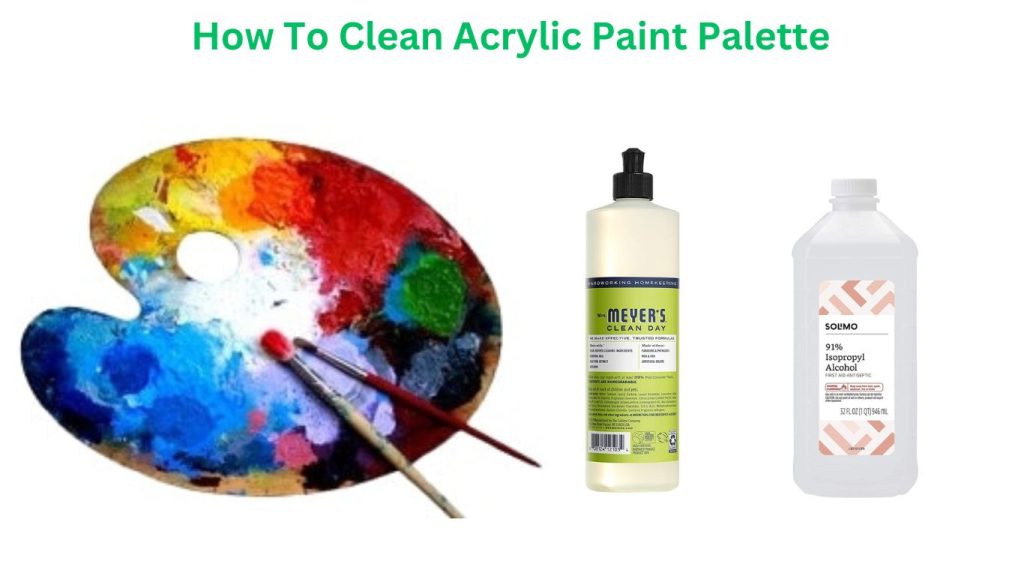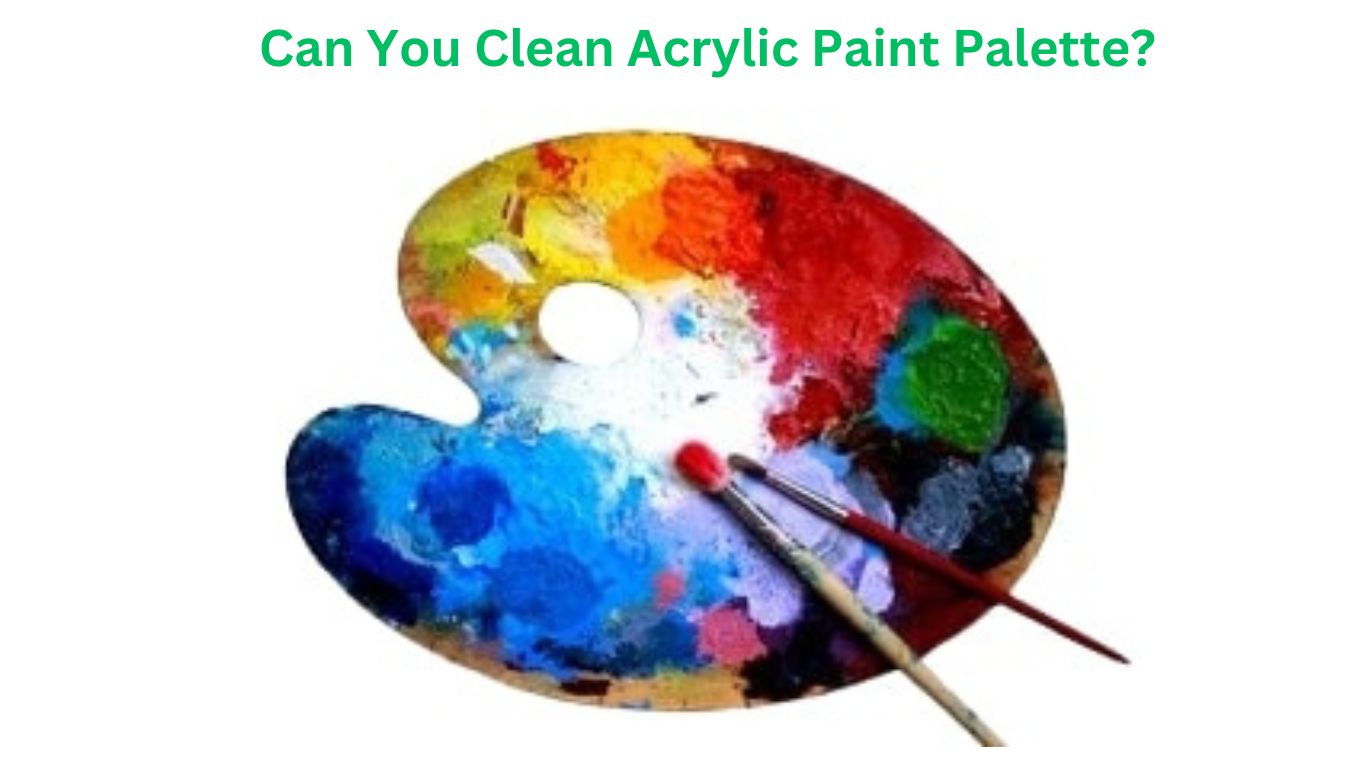Painting is fun, right? But cleaning up the mess afterward sure isn’t! Unfortunately, cleaning the palette is an unavoidable inconvenience every artist has to put up with. Imagine going through all that trouble but not getting the job done properly! It happens more often than you might think.

You can clean your acrylic paint palette by simply washing the colors off in running water. If the paint is still wet, that’s all you need to do. However, the paint might get dry if you don’t wash the palette right away. In that case, a simple rinse won’t work. But there are other tricks you can try to remove dried acrylic paint from the palette.
Getting rid of residual paint from the palette after finishing your painting is a must. If the colors remain, they will mix with the new colors you want to use for a different project. So, there will be an unwanted tone in each of the colors. In this article, we will cover some proven techniques for cleaning acrylic paint from a palette.
Contents
Can You Clean Acrylic Paint Palette?
Yes, you can clean off leftover acrylic paint from your palette. In most cases, it’s as simple as wiping it off under running water in the sink. However, it gets more challenging if the paint dries off. You will have to consider applying an acrylic medium to soften the paint or simply scraping it off the palette. We’ll discuss these in more detail later.

Try to wash the palette as soon as you can. Acrylic paint tends to dry off fast, so if you don’t act instantly, it will become a more difficult job for you. When the paint remains hydrated, it is far easier to remove. Why does this happen? What changes take place in a matter of minutes that makes the cleaning process much harder than before?
Acrylic paint is water-soluble when wet but becomes water-resistant when dry because it is formed of pigments dispersed in an acrylic polymer solution. Because of their chemical composition, acrylic paint pigments can hold onto surfaces better when they are in a dry state. So, you will have to draw up special strategies to clean dry acrylic paint.
How to Clean Acrylic Paint Palette: Different Ways
Here’s something you should never forget after wrapping up your painting session: CLEAN THE PALETTE! If you leave a leftover mix of paint there, mainly acrylic paint, it will dry off and stay there forever unless you clean them the right way, of course! Here are some tips for washing acrylic paint palettes:
Method 1. Wash it off With Soap and Water
When we try cleaning something, we first tend to flush it with water. That actually works well for acrylic paint under certain conditions. When the paint is fresh, a strong stream of tap water could be enough to get the job done. You might also use some soap and detergent to accelerate the process.
As we mentioned above, wet acrylic paint dissolves in water. That is why acrylic paint is very easy to clean when it is wet. We must reiterate that trying to clean hardened dry acrylic paint will be a futile effort. The simplest solution only works if you clean the palette as soon as you are done painting.
Step 1.
Pick up a palette knife and clean the dried bits of paint from the palette with it.
Step 2.
Soak up any leftover paint with a paper towel. Wash the palette using soap and water afterward.
Step 3.
If you notice any dried paint in the palette, try washing it with warm water. Water molecules move faster at a higher temperature. Therefore, warm water can dissolve matter faster than regular-temperature water.
(NOTE: Even warm water might not be enough to dissolve hardened, plastic-like dry acrylic paint. But, you should give it a try. If the paint does not get hard enough, warm water might do the trick.)
Step 4.
Wipe the palette with a paper towel after cleaning it with warm water. The paint globs should come off. Dispose of the paper towels after wiping the palette.
(NOTE: Don’t flush acrylic paint globs down the sink pipe. Even though acrylic paints are mostly safe, they could have toxic effects on the human body if ingested in large volumes. If paint globs go down the sink, there is a risk of water contamination. Better safe than sorry!)
Method 2. Peel off The Globs
Acrylic paint dries into a hard acrylic resin, so you can actually peel it off the palette after it’s completely dried. This works best for glass and plastic palettes. In our experience, you will have a hard time peeling off the paint globs if you are using a wooden palette. But you should give it a shot anyhow.
- Step 1. Take a palette knife and remove as much of the paint as you can with it.
- Step 2. Tightly grab the edge of the palette with one hand and try peeling off the paint globs with another hand. Acrylic paint particles have less traction on glass and plastic surfaces, compared to wood. So, if you are using glass and plastic palettes, the paint globes should come off easily.
- Step 3. Take the palette knife again and try to carve out the remaining paint.
- Step 4. Finish up by wiping the palette with a piece of paper towel.
Method 3. Try Acrylic Medium Gel
Acrylic paints already have a versatile range of qualities. You can expand their abilities even further using acrylic medium gel. These chemical compounds can alter the texture of the paint, slow down drying and make the paint thicker. Mediums are like superhero serum that enhances the capabilities of acrylic paints.
Painters usually use these mediums to tweak the necessary attributes of the paint to their liking. But you can also use mediums to remove acrylic paint from palettes. This technique would best suit glass, plastic, and ceramic palettes. We are not so optimistic about its effectiveness for wooden palettes, however.
- Step 1. Take a tube of acrylic medium gel and squeeze some on top of the layers of colors on the palette.
- Step 2. Allow the gel to dry. This will take some time. We are talking for three to four hours. So, you can go do something else in the meantime.
- Step 3. After the medium settles down on the paint, it will create a thick layer over the paint. You can peel it off easily. Once you start peeling, you will notice that the paint is coming off with it.
- Step 4. If you can’t get all the paint off by hand, try using a palette knife. It will take some work, but once you are done, the palette should be as spotless as new.
- Step 5. Wipe the palette with a dry paper towel to remove the tiny paint flakes that gets left behind.
Method 4. Use Acetone
Acetone is a common ingredient in nail polish removers. It can be a good choice for acrylic paint removal as well. However, there are reasons to feel a bit hesitant about using acetone. Number one, it is a harsh cleaning agent. It could damage your palette material unless you use it in moderation.
Number two, it leaves a strong odor. That said, all these are avoidable scenarios. You can take care of the smell with a simple soap-water rinse later. Acetone is highly effective in removing multiple forms of paint. So, if you have some stubborn paint marks that refuse to go away, you can go for acetone.
- Step 1. Take a piece of cloth or a cotton swab and soak it in acetone.
- Step 2. Rub the paint-covered areas. The paint should come off after a few wipes.
- Step 3. Wash off the acetone with soap and water.
Method 5. Try Rubbing Alcohol
Rubbing alcohol is a popular choice for disinfecting and cleaning. It’s an isopropyl alcohol solution that usually contains 70% of the substance.
Rubbing alcohol is available in different concentrations, but for our use, we will settle for the most common variant. Going too heavy on isopropyl alcohol might not be ideal for all palette materials.
- Step 1. Dilute the rubbing alcohol. A 1:3 solution will work fine. Don’t use rubbing alcohol on palettes without diluting it. If you do, it will damage the palette material.
- Step 2. Put the mixture in a spray bottle and spray it over the residual paint.
- Step 3. Use a piece of cloth to wipe the paint off.
- Step 4. Thoroughly rinse the palette afterward to make sure no rubbing alcohol stays left.
Final Words
Acrylic paints can be a nuisance to get off of some surfaces. We would advise not using wood and polystyrene palettes. The latter, in particular, can be a nightmare to clean after putting acrylic paint on it.
Use an appropriate palette for acrylic paint, like glass and ceramic, and try to clean it as soon as you can after finishing a painting for the day.
